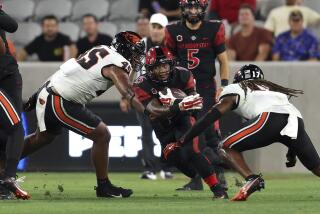College football’s spotlight shines on Boise State and its unique stage
Reporting from Boise, Idaho — At Boise State University, where the color of the football turf mirrors that of a deep-blue pond, the curious seek to confirm tales of water-seeking birds diving to feathery deaths on the stadium surface — yarns just plausible enough to keep a myth alive.
“I can neither confirm nor deny,” says university Athletic Director Gene Bleymaier, tongue planted firmly in cheek.
What can be verified is that the blue artificial turf at Bronco Stadium has achieved no small level of fame, spawning copycats and prompting the school to seek federal trademark protection.
“It was a shock when I first saw it,” says Geraldo Hiwat, a freshman receiver from Holland who knew little about Boise State — except for the turf — when he came to the United States for his senior year of high school. “I made a picture and sent it back to Holland. I couldn’t wait to … tell everyone I played on the blue field.”
Opponents are not so enthusiastic. Some complain that the field camouflages the home team’s uniforms, creating a competitive edge.
“It is an advantage for sure,” says Coach Mike Riley, whose Oregon State team plays at Boise State on Saturday. “Even starting out watching them on film, looking at the numbers, it all blends together when you’re trying to scout them.”
But what might look like a splotch of blue on a scouting video is an integral part of a brand that has set what used to be an Idaho junior college apart from the rest of the nation’s 120 major-college teams. Introduced in 1986, the blue turf was famous long before the school’s football program — ranked No. 3 in the nation in this week’s media and coaches’ polls — started winning on college football’s biggest stages.
“It’s our swoosh,” Bleymaier says of the field. “What the swoosh is to Nike, the blue field is to Boise State.”
Like Norma Desmond in “Sunset Boulevard,” the turf is ready for its close-up. Saturday’s game between the Broncos and 24th-ranked Oregon State will be nationally televised in prime time — 5 p.m. on Channel 7 in Los Angeles.
Boise State needs a victory to keep its hopes of becoming the first school from outside college football’s six major conferences to play for a Bowl Championship Series national title. Just as important in Boise, it’s also the night for rolling out a brand new blue carpet.
As for the old stuff, swatches of it have been cut up and sold on Craigslist. Some alumni have used pieces of the turf to frame their diplomas.
Any talk of returning to the traditional green is considered blasphemous.
“Blue is what got us started, and why should we get rid of it?” says Scott Huff, a student at Boise State in his sophomore year. “Imagine if we lost our first game on green grass.”
Bleymaier, the godfather of Boise’s blue grass, grew up in San Pedro, played football at UCLA in the early 1970s and was an assistant athletic director for the Bruins before arriving at Boise State in 1981. A few years later, during a long airplane flight, he hatched what he acknowledged was a cockamamie plan to replace the field’s green artificial surface.
For $750,000, the school was “going to take out a green field and put in another green field,” Bleymaier recalls thinking. “And nobody is going to notice or care.
“That bothered me. If I paint my house, I paint it a different color so the neighbor knows I painted my house.”
Boise State’s school colors were orange and blue. He knew orange wouldn’t fly, but what about blue?
He took the idea to John Keiser, who was then president of the university.
“I got this idea,” Bleymaier recalls telling Kaiser, “You’re going to think I’m crazy.”
Keiser asked for a few days to consider it and returned with the answer: “Let’s do it.”
No one was told — not even the football coach.
When Boise State held a news conference to announce the green field was going blue, the general consensus was: These guys are crazy.
Bleymaier then called AstroTurf, which had produced Boise’s fake grass since 1970, and put in his order for blue. The company balked. But AstroTurf changed its tune and embraced the color after Bleymaier suggested he might take his business elsewhere.
Getting the color right, though, was another challenge. Substituting blue dye for green wasn’t technically difficult. The problem was, they had about 200 shades of blue to consider.
“Pretty close” does not work with school colors. Texas’ teams do not wear orange, but burnt orange, and Alabama’s red is crimson.
“It can’t be Navy blue, it can’t be dark blue,” Bleymaier says. “It can’t be aqua blue, it can’t be powder blue like UCLA.” Boise’s is called reflex blue, which is close to Navy’s blue but not quite as dark.
AstroTurf said it would try its best.
Bleymaier scheduled the installation for the heart of summer, when the campus would be mostly empty.
“I’m the only one in the stadium,” he recalls, “It’s 95 degrees, it’s in the afternoon, they’re there on the sideline ready to roll out the first five yards and I’m just going, ‘Please, dear God, please let this be the right color of blue.’ They unrolled the first five yards and I went, ‘Wheeeew!’ ”
Newly installed, the turf lacked any white line markers, prompting some to call it “Lake Bleymaier.” The stories about birds crashing into it started around then — a hoax by a local radio station.
Bleymaier was jogging early one morning on the stadium track when he saw a television cameraman setting up his giant tripod. He recalls the exchange going something like this:
Bleymaier: “Can I help you?”
Cameraman: “I’m here to film the geese crashing on the field.’”
Bleymaier: “Oh, really? Well, you might be here a while.”
Once the games began, the field quickly became known as “Smurf Turf.” Chris Berman of ESPN, in the deepest of baritones, melodramatically dubbed it the “blue plastic tundra.”
Columnist Jim Poore of the Idaho Statesman wrote from Boise State’s 74-0 victory over Humboldt State on opening night: “The creature from the blue lagoon did not pop out of the AstroTurf and gobble up both teams, the cheerleaders and Buster Bronco, proving once and for all that Lake Bleymaier is nothing more than a good promotional idea.”
It proved to be that and more. Given all of the extra attention, the football coaches quickly warmed to the new color after realizing it set Boise apart with players they were recruiting: The Broncos were the team with the funky blue field.
“That’s one of the cool things about college football. There’s a blue field,” says Broncos Coach Chris Petersen, whose teams have won all 26 home games since he took over the football program in 2006. “It’s kind of who we are.”
AstroTurf provided the first three blue fields, but after the original company went bankrupt, FieldTurf was hired in 2008 to install blue field No. 4 at a cost of $817,000.
After two years, though, Boise State requested that the turf be replaced because of complaints by television announcers that too much light was reflecting off the field. Boise State coaches also noted it was difficult to review their games on video.
FieldTurf replaced the field this summer, at no additional cost, with multifilament blades that Bleymaier says should diminish the glare.
In August, Boise State players practiced on the new turf for the first time and said it felt mushy. Bleymaier says it takes weeks for the field to settle — it even requires watering to solidify the turf’s base of rubber pellets — but will be ready to go for Saturday’s home opener.
Oregon State is getting ready too — the school bought 440 gallons of paint to color one of its practice fields blue. “It looks amazing, so just to be on it, in some little way, is preparing you for the environment you’re going to be in,” said Riley, the Beavers’ coach.
At least four high schools in recent years have gone to blue fields, as has the University of New Haven. Boise State responded by securing a federal trademark, Reg. No. 3,707,623, for its blue turf. The university reached a licensing agreement with New Haven and gave its consent to the high school teams.
“We consider the blue turf to be part of our identity, and we place great value on that uniqueness,” says Rachael Bickerton, Boise State’s director of trademark, licensing and enforcement.
In a jarring variation, Eastern Washington on Sept. 18 unveiled its new red turf football field along with a slogan: “Red is the New Green.”
“Boise probably paved the way,” says Bill Chaves, Eastern Washington’s athletic director. “The amount of buzz that field has generated has been tremendous.”
At Boise, even after 24 years, fascination with its blue turf remains. Visitors often bypass more traditional landmarks in town and make a beeline to Bronco Stadium.
“People knock on my door all the time,” Bleymaier says. “ ‘Do you mind? We’re from Minnesota, we’re from Oklahoma. …I’ve got to show my kids the turf!’ ”
More to Read
Go beyond the scoreboard
Get the latest on L.A.'s teams in the daily Sports Report newsletter.
You may occasionally receive promotional content from the Los Angeles Times.











